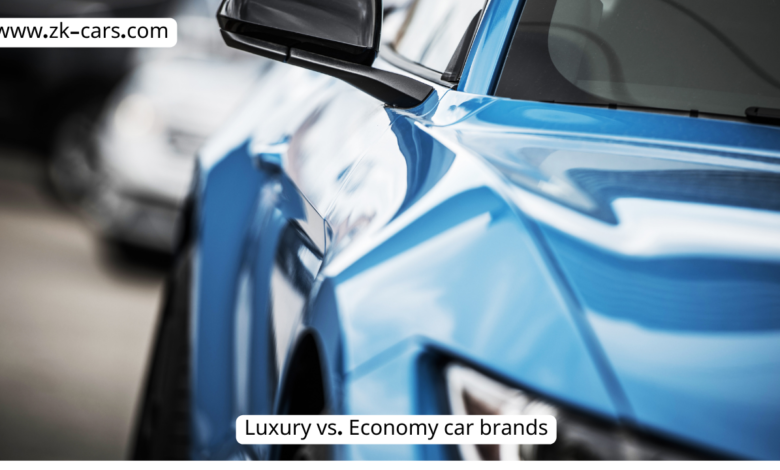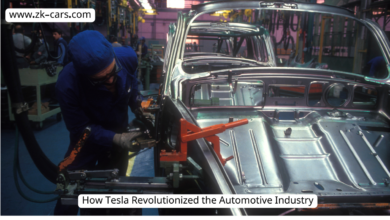luxury-vs-economy-brand-positioning-car-brands
luxury-vs-economy-brand-positioning-car-brands

In the competitive landscape of the automotive industry, brand positioning plays a crucial role in defining how consumers perceive different car brands. Two primary positioning strategies dominate this sector: luxury and economy. These strategies influence everything from marketing techniques to consumer loyalty. In this article, we will explore the key differences between luxury and economy brand positioning, focusing on their implications for car brands, and how these strategies shape consumer choices.
1. Understanding Brand Positioning in the Automotive Industry
Brand positioning refers to the strategy used by companies to create a unique identity for their products in the marketplace. It is about how a brand wants its products to be perceived by consumers compared to competitors. In the automotive sector, effective brand positioning is vital for establishing a strong connection with potential buyers.
A. The Importance of Brand Positioning
Brand positioning not only influences consumer perceptions but also affects purchasing decisions. Consumers often associate certain car brands with specific attributes, whether they be luxury, performance, reliability, or affordability. A well-executed brand positioning strategy helps companies differentiate their products from competitors, create loyal customers, and maximize profits.
B. The Role of Brand Identity
A brand’s identity encompasses its values, personality, and unique selling propositions (USPs). For car brands, these elements shape how consumers interact with the brand. Luxury brands often emphasize quality, exclusivity, and status. In contrast, economy brands focus on affordability, practicality, and functionality.
2. Luxury Car Brands: Positioning for Prestige
Luxury car brands like Mercedes-Benz, BMW, and Lexus position themselves as symbols of status and sophistication. They cater to consumers who value high-quality craftsmanship, advanced technology, and exclusive features.
A. Target Audience of Luxury Brands
Luxury car brands primarily target affluent consumers who seek more than just transportation. Their customers are often professionals, celebrities, and high-net-worth individuals who desire a vehicle that reflects their success and social standing.
B. Key Characteristics of Luxury Car Brands
- Premium Pricing: Luxury brands maintain high price points to reinforce exclusivity and perceived value.
- Superior Quality: They utilize high-end materials, advanced technology, and meticulous craftsmanship.
- Exceptional Customer Experience: Luxury brands often provide personalized customer service, including bespoke options and after-sales support.
- Limited Availability: Many luxury brands produce vehicles in limited quantities to enhance exclusivity.
C. Marketing Strategies for Luxury Brands
Luxury car brands invest heavily in marketing campaigns that evoke emotions and aspiration. They often collaborate with celebrities, host exclusive events, and showcase their vehicles in high-end locations. The messaging focuses on lifestyle rather than just the product itself, making potential customers feel that owning a luxury car is part of an elite social status.
3. Economy Car Brands: Positioning for Accessibility
In contrast, economy car brands like Toyota, Honda, and Kia focus on affordability and practicality. These brands target a broader audience, offering reliable and cost-effective vehicles.
A. Target Audience of Economy Brands
Economy car brands cater to cost-conscious consumers, including families, young professionals, and first-time buyers. Their target audience prioritizes functionality, reliability, and value for money over luxury and prestige.
B. Key Characteristics of Economy Car Brands
- Affordable Pricing: Economy brands keep their prices low to attract budget-conscious consumers.
- Functional Features: These vehicles often emphasize practicality, focusing on features that enhance usability.
- Reliability: Economy brands typically have strong reputations for durability and long-lasting performance.
- Wide Availability: Economy cars are available through various dealerships and online platforms, ensuring easy access for consumers.
C. Marketing Strategies for Economy Brands
Economy car brands use straightforward marketing strategies that highlight the benefits of affordability and functionality. Their advertising often focuses on promoting cost-saving features, safety ratings, and long-term reliability. They engage in mass marketing techniques, utilizing television commercials, online advertisements, and social media to reach a broader audience.
4. The Core Differences Between Luxury and Economy Brand Positioning
Understanding the differences between luxury and economy brand positioning is crucial for automotive companies. Here, we will explore several key factors that distinguish these two strategies.
A. Price and Perceived Value
The most significant difference between luxury and economy brands is price. Luxury brands command higher prices due to their perceived value, quality, and exclusivity. Consumers are often willing to pay a premium for the status and lifestyle associated with luxury vehicles.
In contrast, economy brands focus on affordability. Consumers choose these vehicles primarily based on price and functionality. The perceived value of economy brands lies in their reliability and cost-effectiveness rather than exclusivity.
B. Target Market and Audience
Luxury brands cater to a niche market, targeting high-income consumers seeking status symbols. This audience values the emotional appeal of owning a luxury vehicle. On the other hand, economy brands aim for a broader market, targeting middle-income consumers and families who prioritize practicality and affordability.
C. Emotional vs. Practical Appeal
Luxury brands appeal to consumers’ emotions, emphasizing the lifestyle and status that come with ownership. Consumers often feel a strong emotional connection to luxury brands, seeing them as extensions of their identity.
In contrast, economy brands focus on practicality. Their messaging centers around how well the product meets everyday needs. The emotional connection with economy brands is often functional rather than aspirational.
D. Distribution and Availability
Luxury brands often limit the availability of their products to maintain exclusivity. They may have fewer dealerships and limited production runs, which enhances the desirability of their vehicles.
In contrast, economy brands prioritize wide distribution. Their vehicles are available through numerous dealerships and online platforms, making them easily accessible to consumers.
E. Customer Experience and Service
Luxury brands emphasize providing exceptional customer experiences. They often offer personalized services, such as bespoke options and dedicated customer support.
Economy brands focus on efficient customer service, ensuring that consumers can easily access information and assistance. While the experience may not be as luxurious, it aims to be straightforward and functional.
5. Bridging the Gap: The Evolution of Brand Positioning
While luxury and economy car brands have traditionally occupied distinct segments of the market, the lines between them are becoming increasingly blurred. Many brands are now adopting strategies that incorporate elements from both ends of the spectrum.
A. Premium Lines within Economy Brands
Some economy brands have introduced premium product lines to appeal to higher-income consumers. For example, Toyota launched the Lexus brand to target the luxury market while maintaining its core economy lineup.
B. Affordable Options within Luxury Brands
Conversely, luxury brands are expanding their portfolios to include more affordable options. This approach helps them reach a broader audience without diluting their brand identity. For instance, BMW has introduced models that cater to entry-level luxury consumers.
6. The Future of Brand Positioning in the Automotive Industry
As consumer preferences evolve, the future of brand positioning in the automotive industry will likely focus on personalization and sustainability. Here are a few trends shaping the future:
A. Personalization and Customization
Consumers increasingly expect personalized experiences, even in the automotive sector. Luxury brands will need to enhance their offerings by providing more customizable options. Economy brands can also tap into this trend by offering features that allow customers to tailor their vehicles to their preferences.
B. Sustainability and Eco-Friendliness
As environmental awareness grows, both luxury and economy brands are embracing sustainability. Consumers are looking for eco-friendly vehicles, regardless of brand positioning. Luxury brands may emphasize the use of sustainable materials, while economy brands might focus on fuel efficiency and affordability of electric vehicles.
C. Technological Advancements
Technology continues to transform the automotive landscape. Consumers are increasingly interested in advanced features such as autonomous driving, connectivity, and smart technology. Both luxury and economy brands must stay competitive by integrating these technologies into their offerings.
D. Social Responsibility and Brand Ethics
Consumers today are more socially conscious than ever before. Both luxury and economy brands will need to demonstrate their commitment to ethical practices. This includes transparency in sourcing materials, fair labor practices, and community engagement.
Conclusion
In conclusion, brand positioning in the automotive industry significantly influences how consumers perceive car brands. Luxury brands focus on exclusivity, quality, and status, while economy brands prioritize affordability, practicality, and accessibility. Understanding these differences is essential for automotive companies to effectively reach their target audiences.
As consumer preferences evolve, the lines between luxury and economy car brands will continue to blur. The future of brand positioning will likely involve personalized experiences, sustainable practices, and technological advancements. Brands that can adapt to these changes will be better positioned to thrive in the competitive automotive landscape.
Frequently Asked Questions (FAQs)
- What is brand positioning in the automotive industry? Brand positioning is the strategy used by car manufacturers to create a unique identity for their vehicles in the marketplace, influencing consumer perceptions and purchasing decisions.
- What are luxury car brands? Luxury car brands are those that position themselves as high-end, offering superior quality, advanced technology, and exclusive features, such as Mercedes-Benz, BMW, and Lexus.
- What are economy car brands? Economy car brands focus on affordability and practicality, catering to budget-conscious consumers. Examples include Toyota, Honda, and Kia.
- How do luxury and economy brands differ in marketing? Luxury brands use aspirational marketing, focusing on lifestyle and exclusivity, while economy brands emphasize affordability and functionality in their advertising.
- Will the distinction between luxury and economy car brands continue to exist? While the distinction remains, the lines are becoming blurred as brands adopt strategies that incorporate elements from both categories to appeal to a wider audience.




